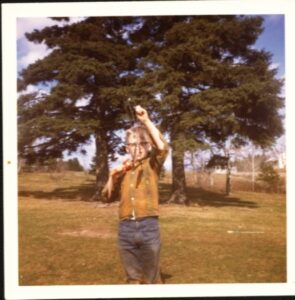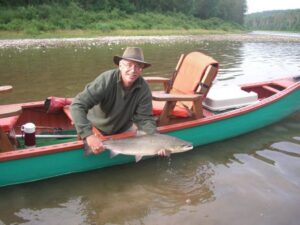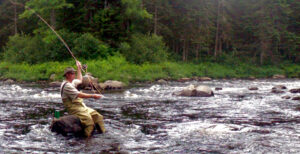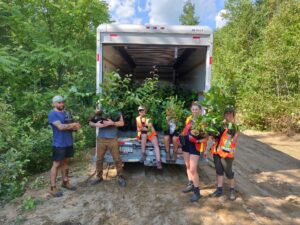New Brunswick has some amazing rivers and some of the best fishing. Both have been important in shaping the identity of New Brunswickers. Being by, and in the water, is part of a traditional way of life that has been passed on from generation to generation. The salmon fishing industry in particular has always played a very important role in the lives of the residents of New Brunswick, and especially for those of us living in the Nashwaak watershed.
The recreational salmon fishery provides vital employment for the fishing lodges and regional ecotourism. However, the Nashwaak River, once so plentiful in salmon, has seen a decreasing trend in the number of fish returning to the ocean for over 20 years (see our previous article about the decline)
Gary Spencer, a Nashwaak resident; fly fisherman of the Nashwaak river; and a dedicated volunteer of the Nashwaak Watershed Association and other organizations like the NB Salmon Council, shares his thoughts and experiences about salmon fishing and how the decline of salmon returns has impacted the fishers and the residents of the area.
Aliza: When was the first time you went fishing? 
Gary: I was 6 or 7 years old and my brother and I fished for trout in Sands Brook. I caught a 7″ trout. My mom made a big deal about it and we ate it (and others) for supper.
 Aliza: What do you love about salmon fishing?
Aliza: What do you love about salmon fishing?
Gary: The challenge of it. It can actually be very difficult at times. I also like the time to reflect on during those long stretches of inaction. I take that time to learn bird songs, notice rocks that have moved since I visited that spot last summer, and reunite with friends. The best part is the sudden “pull,” when a salmon takes the fly and you experience the completely unpredictable behaviour of a salmon on the line.
Aliza: What was the largest salmon you have caught in the Nashwaak?
Gary: It was 18 pounds, caught at a little known (and secret!) pool near Stanley.
Aliza: What was your most memorable moment while fishing?
Gary: That would be the memory of my son catching his first salmon. Having me as a dad he said, “I guess I should let this salmon go” and I told him there are 2 reasons I accept for killing a salmon, if it is 24.5″-long male (and therefore not going to spawn) right at the end of a long fishing day, or if it is your first one and you want to take it home to show mom, Gary grins.
*note: this year the Department of Fisheries and Oceans instituted a catch-and release only policy for New Brunswick rivers.
Aliza: What concerns you most about the decline of the salmon population in NB and in the Nashwaak?
Gary: What concerns me most is the potential loss of our heritage and friendships that are closely tied to salmon fishing. I miss going to the pools on the Nashwaak or other rivers and meeting friends or making friends amongst the fisher people I would meet there. I am also concerned about the lost money to our local economy and the jobs associated with guiding and getting visitors out on the water. Also, they are a high quality and delicious food source!
Aliza: Do you feel that there is hope for the revival of the Nashwaak salmon population? Do you have thoughts on how we can improve this situation?
Gary: Absolutely there is hope. We saw a substantial recovery of the salmon in the Nashwaak in 2008-2011. In my humble opinion better regulation of the salmon aquaculture industry would bring an immediate and substantial recovery to the Nashwaak stocks. We are working hard on that file. There are other issues we have worked on in the past, but now that such things like our input to the Sisson mine project in the headwaters of the Nashwaak is complete and downstream fish passage at NB Power dams is started we will turn our attention to aquaculture. Salmon populations are very resilient and recover quickly when given a chance.
Aliza: What do groups like the Nashwaak Watershed Association do to help the salmon population on the Nashwaak?
Gary: A great deal! They provided excellent input to the Sisson mine Environmental Impact Assessment and have improved the design of the project by doing so. They also contributed to an independent 3rd party review of the mine’s bonding requirements, water treatment costs and plans, and the tailings dam design. This is good stuff! They also have created hatchery operations when the salmon population was at risk, helped get downstream passage in place on the St. John River (those dams do kill Nashwaak salmon even though they are not placed between the Nashwaak and the Bay of Fundy) and much more.


